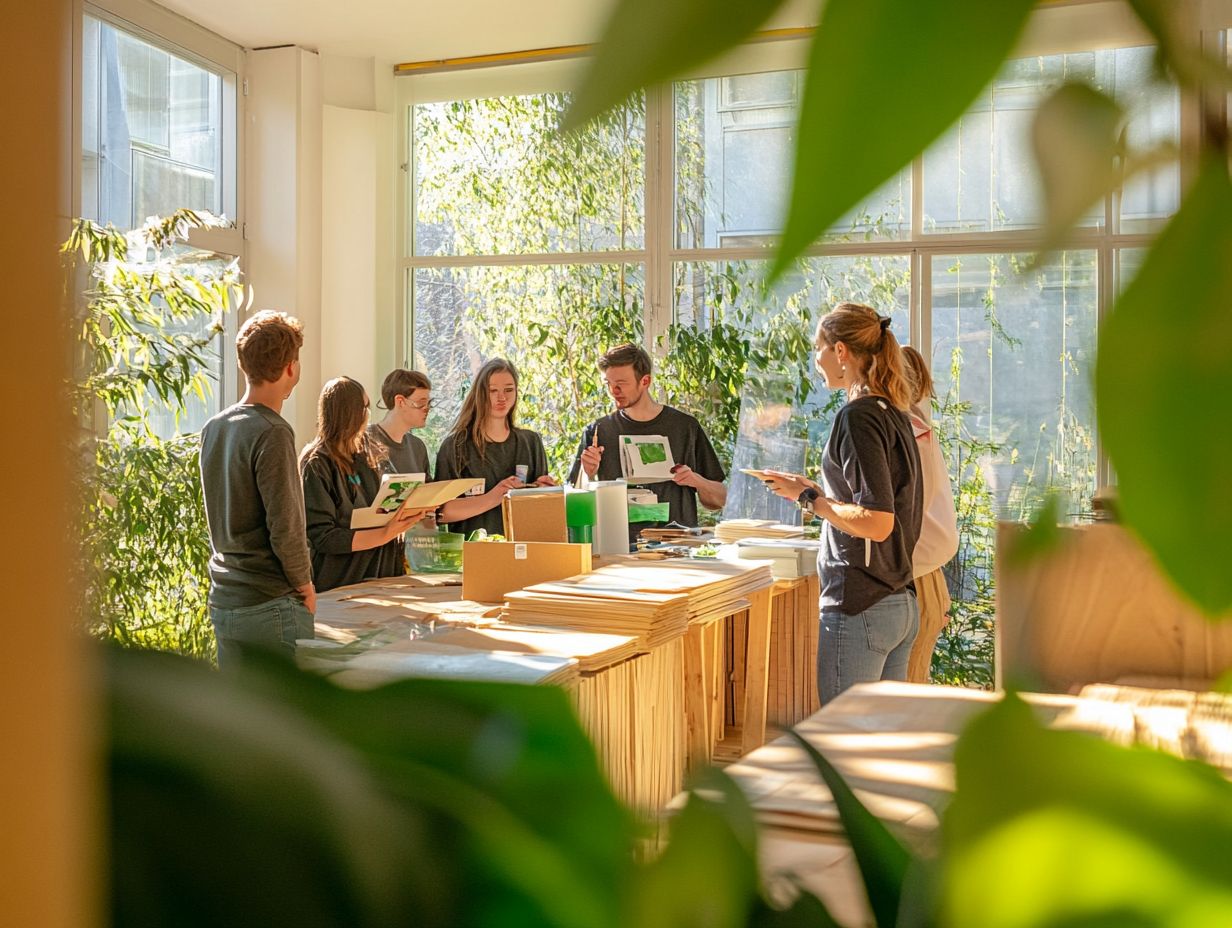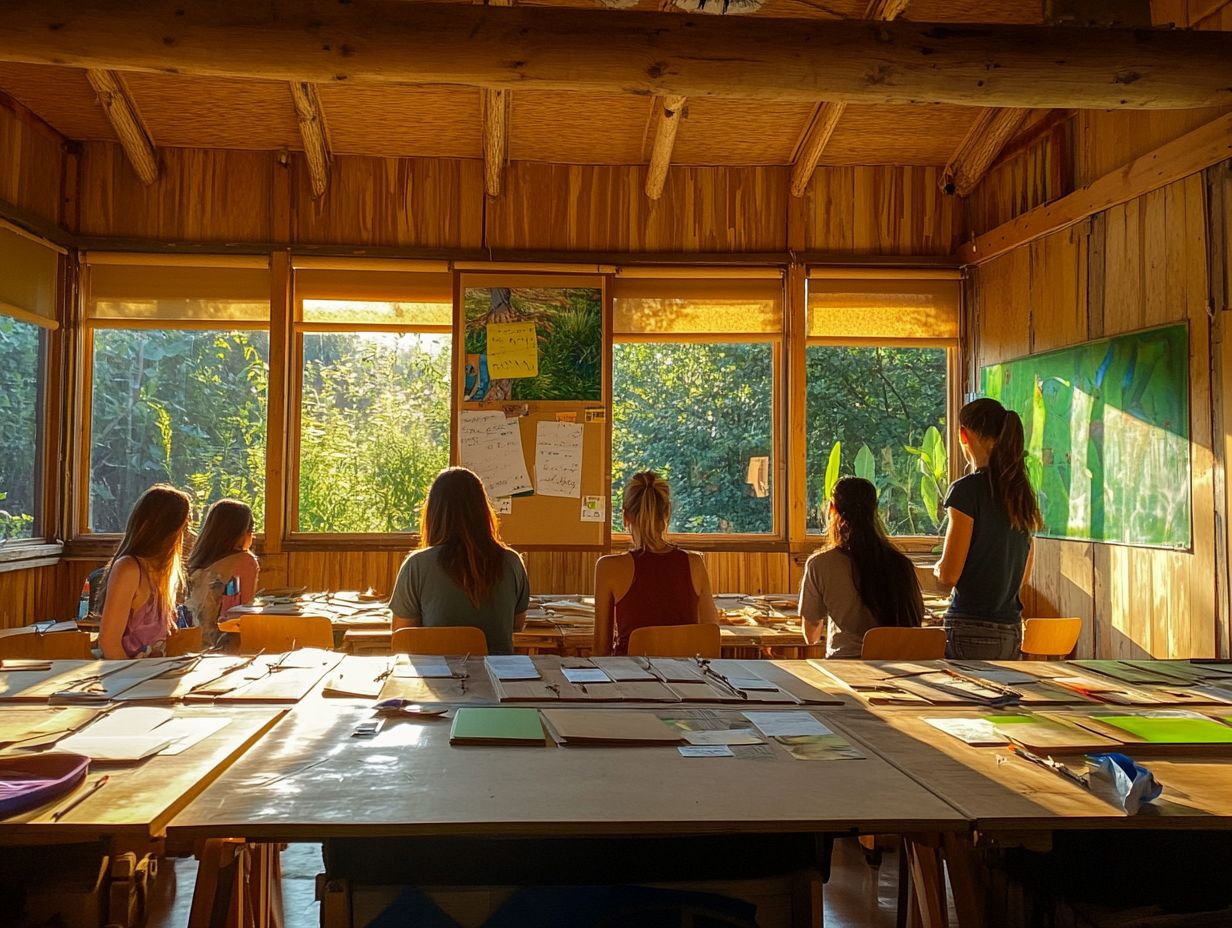The Importance of Education in Sustainable Material Choices
In today’s world, where environmental concerns take center stage, the materials you choose can profoundly influence the health of our planet.
This discussion delves into the intricate relationship between your material choices and environmental sustainability. By grasping the repercussions of unsustainable practices and recognizing the importance of education in guiding informed decisions, you can empower both yourself and your industry.
From showcasing sustainable materials to exploring the challenges and innovations that lie ahead, the goal is to inspire a collective transition toward a more sustainable future.
Together, let s uncover pathways to making better material choices across various sectors.
Contents
- Key Takeaways:
- The Impact of Material Choices on the Environment
- The Role of Education in Promoting Sustainable Material Choices
- Examples of Sustainable Materials
- Implementing Sustainable Material Choices in Different Industries
- Challenges and Barriers to Adopting Sustainable Material Choices
- The Future of Sustainable Material Choices
- Frequently Asked Questions
- What is sustainable material choice?
- Why is education important in sustainable material choices?
- How can education promote sustainable material choices?
- What are the benefits of choosing sustainable materials?
- How can education help individuals and organizations make more sustainable material choices?
- What role does education play in creating a more sustainable future?
Key Takeaways:

- Sustainable material choices have a significant impact on the environment. Understanding the consequences of unsustainable choices is crucial.
- Education plays a vital role in promoting sustainable material choices. It empowers individuals to make informed decisions.
- Examples of sustainable materials include natural and recycled options. Implementing them in various industries positively impacts the environment.
The Impact of Material Choices on the Environment
Your choice of materials carries significant weight in shaping the environment. It affects everything from climate change to the vitality of ecosystems.
As you navigate the complexities of environmental degradation, grasping how selected materials contribute to your carbon footprint is essential. Environmental education is pivotal in this journey, equipping you with the knowledge to recognize the ramifications of unsustainable choices and encouraging eco-friendly living.
Organizations like WWF and Kids.Earth.Org are at the forefront of climate advocacy. They passionately raise awareness about the critical need for responsible consumption and sustainable development in our everyday lives.
Understanding the Consequences of Unsustainable Choices
Unsustainable choices can lead to significant consequences for both the environment and society. They drive climate change, loss of biodiversity, and environmental degradation.
These adverse effects don’t just threaten ecological balance; they also disrupt social structures. It s crucial for you to understand and confront these challenges for the sake of future generations. In this context, climate change education serves as an essential tool in cultivating environmental consciousness.
By leveraging various educational resources, you can inspire critical thinking and enhance problem-solving skills, enabling learners to make informed decisions.
This approach encourages young individuals like you to recognize the urgency of their choices and motivates them to champion sustainable practices, ultimately nurturing a generation dedicated to safeguarding our planet.
The Role of Education in Promoting Sustainable Material Choices
Education serves as a vital cornerstone in fostering sustainable material choices, enabling you with the knowledge and skills necessary to make informed decisions about the materials you select and their environmental implications, including why choosing local sustainable materials is key.
By embracing teaching strategies that prioritize education for sustainable development, you can cultivate an atmosphere where climate-conscious individuals emerge as advocates for responsible consumption.
Engaging in participatory teaching methods allows you to dive into hands-on learning experiences, deepening your understanding of the significance of your choices within the broader context of environmental protection and sustainability.
Empowering Individuals to Make Informed Decisions
Empower yourself to make smart choices about sustainable materials. This is essential for cultivating a culture of responsibility and the ability to take informed actions.
Critical thinking plays a vital role in this journey. It allows you to analyze and evaluate the materials you encounter daily. When you assess how products are made and disposed of, you understand their environmental impact.
Your activism can serve as a powerful catalyst for change within your community. Initiatives like campus-wide recycling programs or community gardens promote sustainable practices and foster meaningful dialogue among your peers.
Successful programs, such as Earth Day clean-up events and awareness campaigns focused on reducing plastic usage, demonstrate how collective efforts inspire a commitment to eco-friendly lifestyles. These experiences encourage you to think critically and act responsibly, making a tangible impact on the world around you.
Examples of Sustainable Materials

Sustainable materials, including natural and recycled options, are essential for mitigating environmental impacts and fostering responsible consumption. By choosing these materials, you contribute to a more sustainable future and ensure your choices align with the well-being of our planet.
Natural and Recycled Materials
Natural materials like bamboo and cork, along with recycled options, lead the charge in sustainable choices. They offer eco-friendly alternatives across a myriad of applications.
These materials reduce your reliance on fossil fuels and significantly cut waste and pollution, making them essential for responsible consumption. For example, many innovative brands are now using organic cotton and recycled plastics in the fashion industry. This shows that sustainability can blend seamlessly with contemporary trends.
In construction, using reclaimed wood and natural insulation materials like hemp dramatically reduces carbon footprints while enhancing the aesthetics of buildings. Highlighting these practical applications showcases their vital role in cultivating a greener future for our planet.
Implementing Sustainable Material Choices in Different Industries
Implementing sustainable material choices across various industries allows you to cut your carbon footprint and help mitigate the effects of climate change.
This approach contributes to a healthier environment and promotes thriving ecosystems. Embracing these practices positions you as a leader in fostering a more sustainable future.
From Fashion to Construction: Case Studies
Case studies from the fashion and construction industries provide invaluable insights into how sustainable materials can be integrated into everyday practices.
These sectors showcase practical applications of eco-friendly resources and highlight the transformative effects such choices can have on the environment and local communities. For instance, when a fashion brand uses recycled fabrics, it does more than just reduce waste; it fosters community engagement through workshops on sustainable practices, nurturing a culture of environmental awareness.
Similarly, a construction company that utilizes bamboo and reclaimed wood minimizes its carbon footprint and creates job opportunities within local economies. The enthusiastic involvement of climate-conscious students in these initiatives underscores the significance of educational outreach, positioning them as vital advocates for positive change.
Through these compelling examples, you can glean valuable lessons on the advantages of adopting sustainable materials. This paves the way for a more eco-friendly future across various industries.
Challenges and Barriers to Adopting Sustainable Material Choices
While the advantages of sustainable material choices are clear, numerous challenges and barriers hinder their widespread adoption. These hurdles are deeply rooted in economic, social, and cultural factors.
Take action today! Consider how you can incorporate sustainable materials into your life and encourage those around you to do the same.
Economic, Social, and Cultural Factors

Economic challenges, such as rising costs of sustainable materials, along with social and cultural hurdles, significantly limit the adoption of sustainable practices.
Businesses often grapple with financial constraints when investing in eco-friendly technologies or sourcing renewable resources. These challenges can create hesitation around making long-term commitments to sustainability. Social challenges like consumer skepticism toward green products and cultural resistance to change further complicate decision-making.
For example, in the fashion industry, sourcing sustainable fabrics can be difficult due to higher production costs. In the food sector, consumers may resist changing their dietary habits.
However, potential solutions such as governmental incentives and favorable environmental policies can alleviate these burdens. They promote innovation and improve education on the benefits of sustainability, guiding firms toward more responsible practices.
The Future of Sustainable Material Choices
The future of sustainable material choices looks promising! Ongoing innovations and advancements are transforming how industries embrace sustainability and environmental responsibility.
Innovations and Advancements in the Field
Exciting innovations in sustainable materials, driven by technological advancements and a growing awareness of environmental education, are revolutionizing industries and enriching ecosystems.
These innovations include biodegradable plastics made from renewable resources and cutting-edge compostable fibers that effectively reduce landfill waste. By integrating materials like hemp, mycelium, or recycled textiles, businesses can shrink their ecological footprint while unlocking opportunities for sustainable design.
The importance of environmental education in this journey cannot be overstated. It enables individuals and businesses to explore the myriad possibilities and advantages of these materials. This knowledge fosters a culture that cherishes sustainability, inspiring more people to make eco-conscious choices in their projects, products, and daily lives.
Frequently Asked Questions
What is sustainable material choice?
Sustainable material choice refers to the decision to use materials that have a lower impact on the environment and society, both in their production and throughout their life cycle.
Why is education important in sustainable material choices?

Education is crucial because it helps individuals and organizations understand the impact of their material choices, highlighting the importance of transparency in sustainable materials, enabling them to make informed decisions to reduce their environmental footprint.
How can education promote sustainable material choices?
Education raises awareness about the importance of considering the environmental and social impact of materials, highlighting why sustainable materials matter in home design. It provides information about sustainable alternatives and teaches skills for making sustainable choices.
What are the benefits of choosing sustainable materials?
Choosing sustainable materials offers numerous benefits, including reducing resource depletion, minimizing pollution and waste, improving human health, and promoting social responsibility and equity.
How can education help individuals and organizations make more sustainable material choices?
Education equips individuals and organizations with the knowledge and skills to assess the sustainability of different materials. It helps them understand trade-offs and benefits, enabling informed decisions based on specific needs and values.
Now, more than ever, it’s crucial to make sustainable choices. Explore your options and participate in sustainability initiatives to make a positive impact!
What role does education play in creating a more sustainable future?
Education is key to a sustainable future! It encourages everyone to think about the environment and make better choices.
By promoting the use of sustainable materials, education empowers individuals and organizations to act responsibly in their daily lives.






